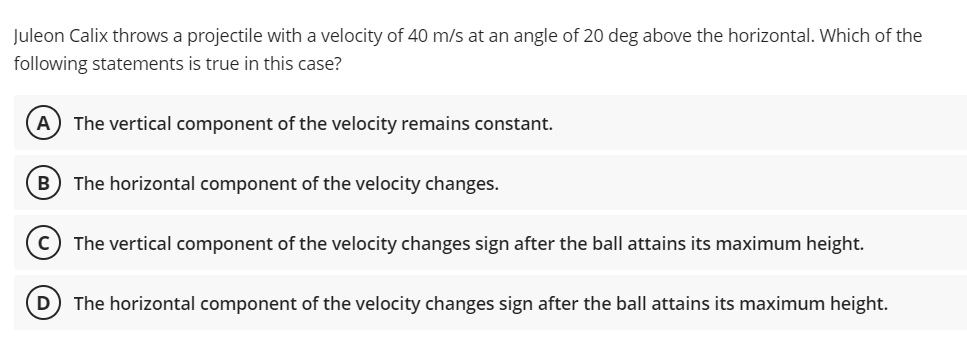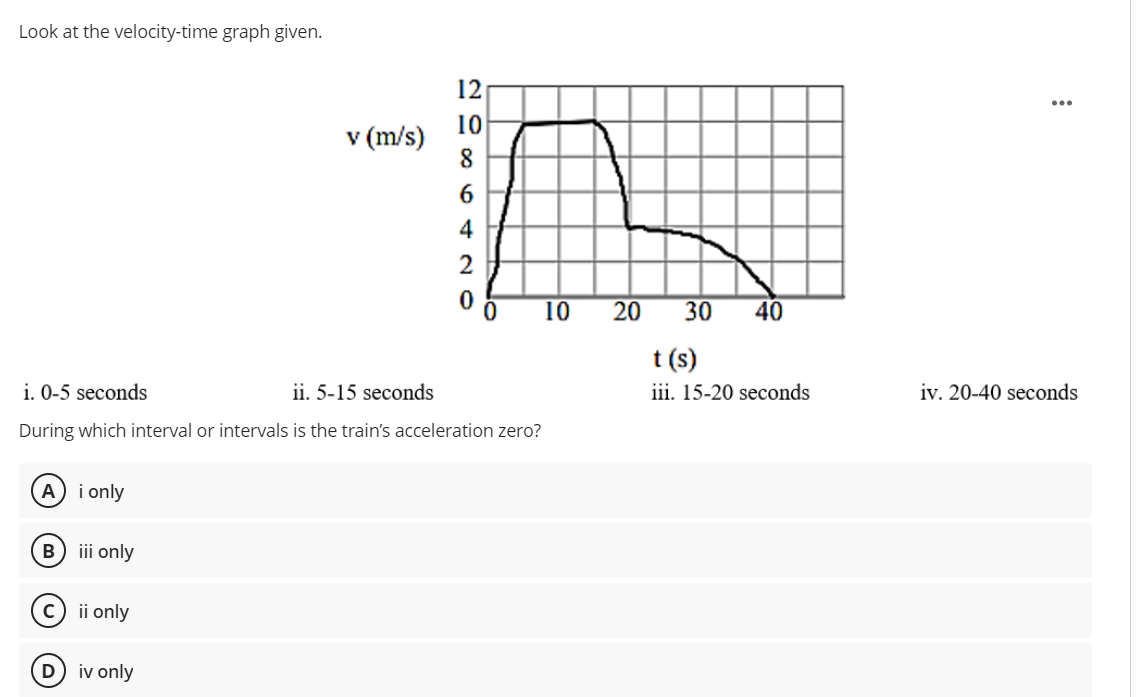Juleon Calix throws a projectile with a velocity of 40 m/s at an angle of 20 deg above the horizontal. Which of the following statements is true in this case? A) The vertical component of the velocity remains constant. B) The horizontal component of the velocity changes. c) The vertical component of the velocity changes sign after the ball attains its maximum height. The horizontal component of the velocity changes sign after the ball attains its maximum height.
Juleon Calix throws a projectile with a velocity of 40 m/s at an angle of 20 deg above the horizontal. Which of the following statements is true in this case? A) The vertical component of the velocity remains constant. B) The horizontal component of the velocity changes. c) The vertical component of the velocity changes sign after the ball attains its maximum height. The horizontal component of the velocity changes sign after the ball attains its maximum height.
Physics for Scientists and Engineers with Modern Physics
10th Edition
ISBN:9781337553292
Author:Raymond A. Serway, John W. Jewett
Publisher:Raymond A. Serway, John W. Jewett
Chapter4: Motion In Two Dimensions
Section: Chapter Questions
Problem 13P: A student stands at the edge of a cliff and throws a stone horizontally over the edge with a speed...
Related questions
Concept explainers
Topic Video
Question

Transcribed Image Text:Juleon Calix throws a projectile with a velocity of 40 m/s at an angle of 20 deg above the horizontal. Which of the
following statements is true in this case?
A
The vertical component of the velocity remains constant.
B
The horizontal component of the velocity changes.
c) The vertical component of the velocity changes sign after the ball attains its maximum height.
The horizontal component of the velocity changes sign after the ball attains its maximum height.

Transcribed Image Text:Look at the velocity-time graph given.
12
...
10
v (m/s)
6.
4
2
10
20
30
40
t (s)
iii. 15-20 seconds
i. 0-5 seconds
ii. 5-15 seconds
iv. 20-40 seconds
During which interval or intervals is the train's acceleration zero?
A i only
В
iii only
ii only
D) iv only
Expert Solution
This question has been solved!
Explore an expertly crafted, step-by-step solution for a thorough understanding of key concepts.
Step by step
Solved in 5 steps with 1 images

Knowledge Booster
Learn more about
Need a deep-dive on the concept behind this application? Look no further. Learn more about this topic, physics and related others by exploring similar questions and additional content below.Recommended textbooks for you

Physics for Scientists and Engineers with Modern …
Physics
ISBN:
9781337553292
Author:
Raymond A. Serway, John W. Jewett
Publisher:
Cengage Learning

Physics for Scientists and Engineers
Physics
ISBN:
9781337553278
Author:
Raymond A. Serway, John W. Jewett
Publisher:
Cengage Learning

College Physics
Physics
ISBN:
9781285737027
Author:
Raymond A. Serway, Chris Vuille
Publisher:
Cengage Learning

Physics for Scientists and Engineers with Modern …
Physics
ISBN:
9781337553292
Author:
Raymond A. Serway, John W. Jewett
Publisher:
Cengage Learning

Physics for Scientists and Engineers
Physics
ISBN:
9781337553278
Author:
Raymond A. Serway, John W. Jewett
Publisher:
Cengage Learning

College Physics
Physics
ISBN:
9781285737027
Author:
Raymond A. Serway, Chris Vuille
Publisher:
Cengage Learning

Principles of Physics: A Calculus-Based Text
Physics
ISBN:
9781133104261
Author:
Raymond A. Serway, John W. Jewett
Publisher:
Cengage Learning

Physics for Scientists and Engineers, Technology …
Physics
ISBN:
9781305116399
Author:
Raymond A. Serway, John W. Jewett
Publisher:
Cengage Learning

Glencoe Physics: Principles and Problems, Student…
Physics
ISBN:
9780078807213
Author:
Paul W. Zitzewitz
Publisher:
Glencoe/McGraw-Hill